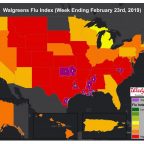African Americans Less Likely To Get Flu Vaccine Than White Americans
The U.S. is still in flu season, but many are choosing to forgo vaccination. A new study looks at how people view risks associated with the virus and the vaccine, how views differ between white and African American individuals, and solutions that may help counter misperceptions.
Fewer than half of American adults get vaccinated despite strong recommendations from the Centers for Disease Control and Prevention (CDC) and widespread availability of free and low-cost vaccines. Furthermore, African Americans are less likely to get the flu shot than white Americans, and concerns about side effects from the vaccine play a large role in this disparity. According to the CDC, only 41 percent of African American adults received the flu vaccine compared with 47 percent of white adults.
For those who opted not to get vaccinated, the risk of suffering side effects from the vaccine seemed greater than the risk of getting the flu itself, according to the new study, “The role of risk perception in flu vaccine behavior among African American and white adults in the US,” published in the latest issue of the journal Risk Analysis. One of the reasons white participants decided to forgo vaccination was because they did not view getting sick with seasonal flu as a “big deal.” Many African Americans said they worried about the safety of the shot itself.
The study included 800 white and 800 African American participants. The researchers contracted with Gfk, an international research firm that uses a probability-based online panel, to conduct the survey, which took place in March after peak flu season had ended. The survey instrument was developed based on initial insights gathered from interviews and focus groups with the target audience.
While flu vaccine campaigns often focus on the dangers of the flu, the results of this study suggest that flu vaccine campaigns should also address the perceived risks of vaccination by highlighting how vaccines work.
“The trust of the American people in government is at an all-time low, which also feeds into fear of vaccines,” suggests Vicki Freimuth, lead author of the study and professor of health and risk communication at the University of Georgia. “Most people have very limited understanding of the way vaccine recommendations are determined and how vaccines are made and distributed. Perhaps increasing knowledge about the process and its many contributing organizations may decrease perception of risk from the vaccine.”
Six researchers at the University of Georgia, the University of Maryland and the University of Pittsburgh conducted the research, which was supported by the Center of Excellence in Race, Ethnicity and Health Disparities Research of the National Institutes of Health.
While the researchers found disparities between the two races as a whole, they also found trends that were common between certain demographic characteristics. For example, women and older individuals within both races were more likely to view getting the flu as a bigger risk than vaccine side effects. The researchers found that in the white sample, older, more educated individuals and those with a higher income were less likely to worry about side effects of the vaccine. In the African-American sample, older individuals and those with a higher level of education were also less likely to worry about the risk of side effects, while women viewed the side effects of the vaccine as a bigger threat.
The researchers noted that the results of the study may have been different if they had studied outbreaks such as the H1N1 virus or bird flu. Seasonal flu did not trigger the same emotional reactions as these emergency flu outbreaks, perhaps leading to survey respondents giving greater weight to perceived risks from vaccination.
“One implication for flu vaccine campaigns is very clear. Messages must address both kinds of risk, disease and vaccine,” said Freimuth. “Since flu vaccination is routine and may not stimulate the kind of emotional reactions that an emergency does, the public may be more concerned about vaccine risk than disease risk.”
The researchers say larger studies are now needed to take a closer look at the role risk plays in people’s decisions to get or skip vaccines but they also see immediate opportunities for action.
Risk Analysis: An International Journal is published by the nonprofit Society for Risk Analysis (SRA), an interdisciplinary, scholarly, international society that provides an open forum for all who are interested in risk analysis, a critical function in complex modern societies. Risk analysis includes risk assessment, risk characterization, risk communication, risk management, and risk policy affecting individuals, public- and private-sector organizations, and societies at a local, regional, national, or global level.






